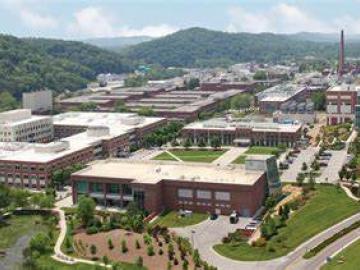Filter News
Area of Research
- Advanced Manufacturing (14)
- Biological Systems (1)
- Biology and Environment (84)
- Biology and Soft Matter (1)
- Building Technologies (1)
- Clean Energy (145)
- Climate and Environmental Systems (4)
- Computational Biology (2)
- Computational Engineering (1)
- Computer Science (2)
- Energy Sciences (1)
- Fusion and Fission (8)
- Fusion Energy (1)
- Isotopes (21)
- Materials (57)
- Materials for Computing (5)
- Mathematics (1)
- National Security (16)
- Neutron Science (22)
- Nuclear Science and Technology (8)
- Quantum information Science (1)
- Supercomputing (40)
- Transportation Systems (2)
News Type
News Topics
- (-) 3-D Printing/Advanced Manufacturing (63)
- (-) Biomedical (37)
- (-) Cybersecurity (17)
- (-) Energy Storage (58)
- (-) Environment (140)
- (-) Isotopes (28)
- (-) Physics (29)
- (-) Space Exploration (21)
- (-) Transportation (60)
- Advanced Reactors (19)
- Artificial Intelligence (51)
- Big Data (35)
- Bioenergy (61)
- Biology (70)
- Biotechnology (12)
- Buildings (33)
- Chemical Sciences (26)
- Clean Water (26)
- Climate Change (63)
- Composites (14)
- Computer Science (115)
- Coronavirus (28)
- Critical Materials (12)
- Decarbonization (46)
- Emergency (2)
- Exascale Computing (22)
- Fossil Energy (3)
- Frontier (20)
- Fusion (36)
- Grid (41)
- High-Performance Computing (49)
- Hydropower (11)
- Irradiation (2)
- ITER (5)
- Machine Learning (28)
- Materials (71)
- Materials Science (68)
- Mathematics (6)
- Mercury (10)
- Microelectronics (2)
- Microscopy (30)
- Molten Salt (6)
- Nanotechnology (28)
- National Security (33)
- Net Zero (7)
- Neutron Science (70)
- Nuclear Energy (67)
- Partnerships (12)
- Polymers (15)
- Quantum Computing (19)
- Quantum Science (34)
- Renewable Energy (1)
- Security (11)
- Simulation (30)
- Software (1)
- Statistics (1)
- Summit (35)
- Sustainable Energy (79)
- Transformational Challenge Reactor (3)
Media Contacts

Rishi Pillai and his research team from ORNL will receive a Best Paper award from the American Society of Mechanical Engineers International Gas Turbine Institute in June at the Turbo Expo 2024 in London.

ORNL’s Omer Onar and Mostak Mohammad will present on ORNL's wireless charging technology in DOE’s Office of Technology Transitions National Lab Discovery Series Tuesday, April 30.

ORNL’s Erin Webb is co-leading a new Circular Bioeconomy Systems Convergent Research Initiative focused on advancing production and use of renewable carbon from Tennessee to meet societal needs.

An international team using neutrons set the first benchmark (one nanosecond) for a polymer-electrolyte and lithium-salt mixture. Findings could produce safer, more powerful lithium batteries.

Shift Thermal, a member of Innovation Crossroads’ first cohort of fellows, is commercializing advanced ice thermal energy storage for HVAC, shifting the cooling process to be more sustainable, cost-effective and resilient. Shift Thermal wants to enable a lower-cost, more-efficient thermal energy storage method to provide long-duration resilient cooling when the electric grid is down.

Scientists at ORNL have developed 3D-printed collimator techniques that can be used to custom design collimators that better filter out noise during different types of neutron scattering experiments
ORNL scientists have determined how to avoid costly and potentially irreparable damage to large metallic parts fabricated through additive manufacturing, also known as 3D printing, that is caused by residual stress in the material.

SkyNano, an Innovation Crossroads alumnus, held a ribbon-cutting for their new facility. SkyNano exemplifies using DOE resources to build a successful clean energy company, making valuable carbon nanotubes from waste CO2.

College intern Noah Miller is on his 3rd consecutive internship at ORNL, currently working on developing an automated pellet inspection system for Oak Ridge National Laboratory’s Plutonium-238 Supply Program. Along with his success at ORNL, Miller is also focusing on becoming a mentor for kids, giving back to the place where he discovered his passion and developed his skills.

A team of researchers at ORNL demonstrated that a light-duty passenger electric vehicle can be wirelessly charged at 100-kW with 96% efficiency using polyphase electromagnetic coupling coils with rotating magnetic fields.




